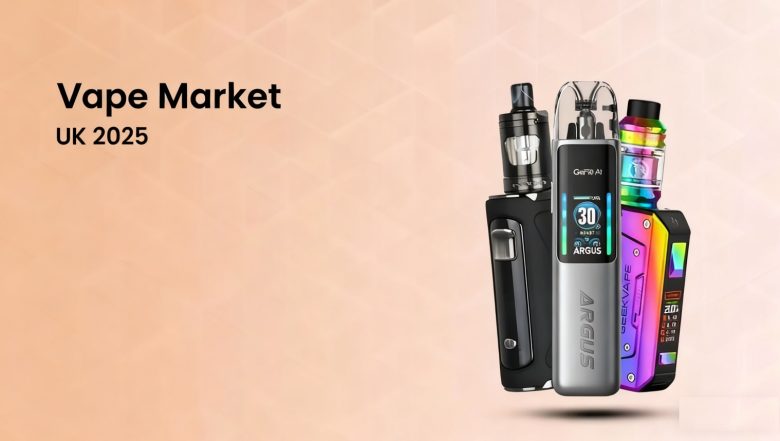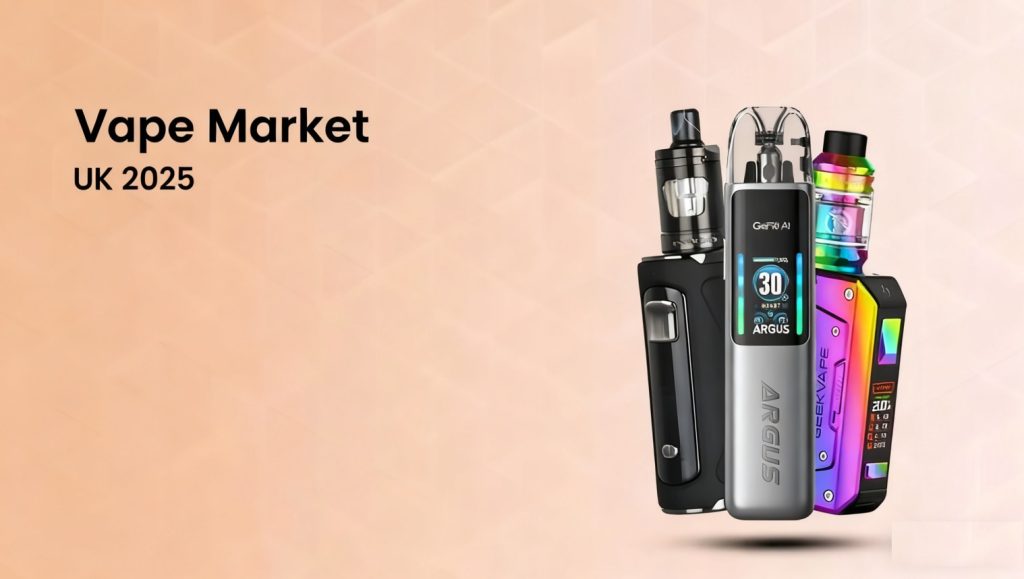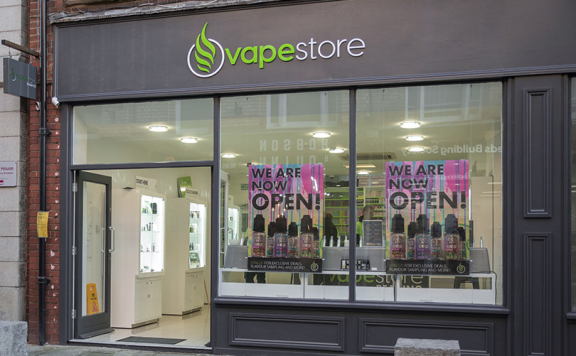The UK vape market remains dynamic and commercially significant, but it is evolving fast. As of 2025, around 5.5 million adults in Great Britain vape, roughly 10.4% of the adult population. The overall user base is now relatively stable rather than rapidly expanding, which means that the priority for retailers is shifting from pure customer acquisition to retention, education and compliance.
At the same time, regulation and consumer behaviour are changing how the market works. The nationwide ban on disposable vapes, the rise of reusable pod systems, and changing flavour preferences are reshaping what customers expect from vape shops, online retailers and wholesalers.
This guide distils key 2025 data and turns it into practical, commercial insights for UK vape businesses.
Table of Contents
1. Core Market Segments: Who Vapes in 2025?
The adult vaping population in Great Britain can roughly be divided into three main groups:
- Ex-smokers who now vape
- Current smokers who both smoke and vape (dual users)
- A small number of never-smokers who vape
Ex-smokers are the largest and most important group. Around 3 million vapers, or about 55%, fall into this category. They are more likely to vape daily and to have been vaping for three years or longer. For retailers, they tend to be loyal and relatively stable customers, especially when they find a device and flavour combination that reliably keeps them away from cigarettes.
Dual users, roughly 2.2 million people (40% of vapers), are the next key segment. About one third of all smokers now vape, but many have not yet fully switched away from combustible tobacco. With the right guidance on device choice, nicotine strength and usage patterns, a proportion of these dual users will transition to exclusive vaping or quit altogether.
Never-smokers who vape are a small and shrinking minority, around 5% of vapers in 2025, down from around 8% in 2024. From both a reputational and regulatory perspective, they should not be an active target audience. Strong age-verification and responsible marketing are essential to avoid being seen as recruiting non-smoking adults into nicotine use.
For retailers, the practical takeaway is clear: focus your product mix, messaging and support on ex-smokers and dual users. This is where most of the volume, and most of the long-term loyalty, will come from.
2. Devices: Disposables Decline, Reusables Take Over
The UK device landscape has changed markedly in just a few years:
- Tank systems remain the single most common device type, used by around half of vapers. They attract experienced users who value flexibility and long-term cost savings.
- Pod devices have grown strongly, used by around a quarter of vapers in 2025, up from around 15% in 2024. Many former disposable brands have launched closed or refillable pod lines to capture this demand.
- Disposable vapes have declined, now used by roughly 24% of vapers, down from a peak of about 31% in 2023.
This market shift has been accelerated by policy. As of 1 June 2025, the UK ban on disposable vapes is in force. A minority of disposable users plan to stop vaping or cut down because of the ban, but survey data suggests that most intend to keep vaping and will switch to reusable pods or tank systems instead.
What this means for your inventory
- Rebuild around reusable systems.
Refillable pods and open-tank kits should now be the backbone of your UK range. Disposable-style convenience needs to be delivered through user-friendly, TPD-compliant pod systems rather than single-use devices. - Create “switching bundles” for ex-disposable users.
Offer starter packs that combine a simple pod device, a small selection of compatible e-liquids within the 20 mg/ml limit, and a clear print or digital quick-start guide. The easier you make the transition, the less drop-off you will see. - Choose devices that feel familiar to disposable users.
For example, a compact, refillable device like the Airis PuriPod SEcan be positioned as a bridge product: it keeps the simplicity and portability disposable users are used to, but adds a larger battery, adjustable power and reusable pods, which make it more economical and environmentally responsible in the long run.
3. Flavour Preferences: Fruit and Cooling Profiles Dominate
Flavour has become a primary driver of product choice:
- Fruit flavours are now the most popular category, used by just over half of vapers, compared with roughly one fifth a decade ago.
- Menthol and mint account for about one fifth of choices.
- Tobacco flavours have declined to around one tenth of the market, down from roughly one third in 2016.
- Cooling or “ice” flavours are used always or sometimes by more than 40% of vapers, particularly in the 18–34 age group.
- For retailers, this means:
- Stock a broad, well-organised range of fruit and fruit-ice profiles, alongside classic menthol and tobacco options.
- Group e-liquids by flavour family (fruit, fruit + ice, menthol/mint, tobacco) rather than only by brand. This matches how many customers think about flavours.
- Use flavour and device bundles to guide customers through a progression: many ex-smokers start with tobacco or menthol, then move to fruit-ice combinations once they are more confident with vaping.
- At the same time, it is important to keep flavour presentation clearly adult-focused. Avoid youth-coded names and imagery, as stricter rules on flavour descriptors and packaging are likely in future legislation.
4. Where and How Vapers Buy: Omnichannel is the Norm
Adult vapers in the UK buy their products across multiple channels:
- A large share usually buys online, attracted by convenience, range and price comparisons.
- Specialist vape shops remain a key channel, especially for new vapers and ex-smokers seeking advice.
- Supermarkets and convenience stores are still important but are less dominant for vapes than for cigarettes.
This split has clear operational consequences.
For brick-and-mortar vape shops:
- Emphasise expert advice, in-person demonstrations and problem solving. Help customers understand coil changes, pod replacement, battery safety and how to choose nicotine strengths.
- Make your store the place people come back to when they want to switch from disposables to pods or tanks, or when they are ready to reduce nicotine strength.
For online retailers:
- Invest in fast, discreet delivery and clear returns policies.
- Build detailed product pages that specify battery capacity, coil resistance, tank or pod volume, intended user type (light, moderate, heavy smoker) and regulatory status.
- Use education-led content – guides, FAQs and comparison articles – to answer common questions and improve organic search performance.
5. Compliance and Risk Management
UK vape retailers now face a tougher regulatory environment than a few years ago. Key requirements include:
- E-liquids must not exceed 20 mg/ml nicotine concentration.
- Tanks and pods must be 2 ml or less; refill bottles must be 10 ml or less.
- Products must carry standardised health warnings covering a defined portion of packaging.
- Single-use, non-rechargeable, non-refillable vapes are banned from sale.
- The Tobacco and Vapes Bill is expected to introduce tighter rules on flavours, packaging and point-of-sale display.
To stay on the right side of the rules:
- Audit your range regularly and remove any non-compliant SKUs.
- Confirm that your product descriptions match TPD-compliant specifications.
- Implement robust age-verification both in-store (for example, “Challenge 25”) and online (third-party verification or equivalent checks).
- Train your staff so they can explain the disposable ban, TPD limits and device categories clearly to customers.
Content can support this work. A straightforward nicotine strength guide, for example, helps both staff and customers choose appropriate strengths and reduce misuse. You can use resources like the Airis blog article on how to choose the right nicotine strength as a reference when building your own house-branded educational materials.
6. Key Takeaways for UK Vape Sellers in 2025
Bringing these insights together, a clear strategy for UK vape businesses emerges:
- Prioritise ex-smokers and dual users in your planning, as they represent the bulk of demand and the greatest potential for long-term relationships.
- Treat refillable pods and tank systems as your main product categories and design “switching journeys” that move users smoothly away from disposables.
- Build flavour ranges around fruit, menthol and cooling profiles, but ensure that your presentation remains adult-focused and defensible.
- Combine online convenience with in-store expertise; do not rely on a single channel.
- Use education-led content and strong compliance practices as part of your value proposition, not just as a legal requirement.
The UK vape market may no longer be in its explosive growth phase, but it remains large, profitable and strategically important. Retailers that adapt quickly to the post-disposable reality, invest in reusable systems and treat regulation as a framework rather than a burden will be best placed to succeed in 2025 and beyond.




